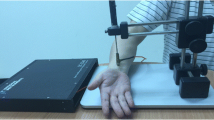Abstract
Pulse palpation is an important diagnostic tool in Traditional Chinese Medicine (TCM) and related Oriental medicine systems. Pulse wave contains a lot of physiological and pathological information. How to effectively extract the information contained in pulse wave has been concerned at home and abroad. In this paper, a comprehensive introduction about the pulse wave characteristic is given. Furthermore, a new method of distinguishing students’ physical constitution based on pulse characteristic information is proposed. First, pulse data were collected, preprocessed and pulse cycles were segmented. Second, time domain and pulse features coefficients of pulse wave were extracted. Finally, useful pulse wave features were evaluated and the features are classified to distinguish students’ constitution by SVM classifier. Number experiments have proved the correctness and feasibility of the proposed theory.
Supported by key project at central government level (2060302).
Access this chapter
Tax calculation will be finalised at checkout
Purchases are for personal use only
Similar content being viewed by others
References
Wu, H.K., Ko, Y.S., Lin, Y.S., Wu, H.T., Tsai, T.H., Chang, H.H.: The correlation between pulse diagnosis and constitution identification in traditional Chinese medicine. Complement. Ther. Med. 30, 107–112 (2017)
Velik, R.: An objective review of the technological developments for radial pulse diagnosis in traditional Chinese medicine. Eur. J. Integr. Med. 7(4), 321–331 (2015)
De, M.N., Cordovil, I., De, S.F.A.: Traditional Chinese medicine wrist pulse-taking is associated with pulse waveform analysis and hemodynamics in hypertension. J. Integr. Med. 14(2), 100–113 (2016)
Zhang, Z., Zhang, Y., Yao, L., Song, H., Kos, A.: A sensor-based wrist pulse signal processing and lung cancer recognition. J. Biomed. Inform. 79, 107–116 (2018)
Qiao, L.J., et al.: The association of radial artery pulse wave variables with the pulse wave velocity and echocardiographic parameters in hypertension. Evid.-Based Complement. Altern. Med. 2018 (2018). Article ID 5291759
Leonard, P., Beattie, T.F., Addison, P.S., Watson, J.N.: Wavelet analysis of pulse oximeter waveform permits identification of unwell children. J Energ. Med. 21, 59–60 (2004)
Xu, L., Wang, K., Li, Y.: Modern researches on traditional Chinese pulse diagnosis. Eur. J. Orient. Med. 8(1), 56–63 (2004)
Jeon, Y.J., et al.: A clinical study of the pulse wave characteristics at the three pulse diagnosis positions of Chon, Gwan and Cheok. Evid.-Based Complement. Altern. Med. 2011 (2011). Article ID 904056
Bae, J.H., Jeon, Y.J., Kim, J.Y., Kim, J.U.: New assessment model of pulse depth based on sensor displacement in pulse diagnostic devices. Evid.-Based Complement. Altern. Med. 2013 (2013). Article ID 938641
Yallapragada, V.J., Rigneault, H., Oron, D.: Spectrally narrow features in a supercontinuum generated by shaped pulse trains. Opt. Express 26(5), 5694–5700 (2018)
Khanna, A., Paul, M., Sandhu, J.S.: Efficacy of two relaxation techniques in reducing pulse rate among highly stressed females. Calicut Med. J. 5(2), 23–25 (2007)
RibeirodeMoura, N.G., Cordovil, I., de S\(\acute{a^{}}\) Ferreira, A.: Traditional Chinese medicine wrist pulse-taking is associated with pulse waveform analysis and hemodynamics in hypertension. J. Integr. Med. 14, 100–113 (2016)
Moura, N.G.R., Ferreira, A.: Pulse waveform analysis of Chinese pulse images and its association with disability in hypertension. JAMS J. Acupunct. Meridian Stud. 9, 93–98 (2016)
Xu, J., Yang, Y.: Traditional Chinese medicine in the Chinese health care system. Health Policy 90(2–3), 133–139 (2009)
Nestler, G.: Traditional Chinese medicine. Med. Clin. 86(1), 63–73 (2002)
Bilton, K., Zaslawski, C.: Reliability of manual pulse diagnosis methods in traditional East Asian medicine: a systematic narrative literature review. J. Altern. Complement. Med. 22(8), 599–609 (2016)
Hajar, R.: The pulse in ancient medicine part 1. Heart Views Off. J. Gulf Heart Assoc. 19(1), 36 (2018)
Tang, A.C.Y., Chung, J.W.Y., Wong, T.K.S.: Validation of a novel traditional chinese medicine pulse diagnostic model using an artificial neural network. Evid. Based Complement Altern. Med. 2012 (2012). Article ID 685094
Huan, E.Y., et al.: Deep convolutional neural networks for classifying body constitution based on face image. Comput. Math. Methods Med. 2017 (2017). Article ID 9846707
Li, X., et al.: Computerized wrist pulse signal diagnosis using gradient boosting decision tree. In: 2018 IEEE International Conference on Bioinformatics and Biomedicine, pp. 1941–1947. IEEE, Madrid, Spain (2018)
Cui, Z., Xue, F., Cai, X., Cao, Y., Wang, G., Chen, J.: Detection of malicious code variants based on deep learning. IEEE Trans. Industr. Inf. 14(7), 3187–3196 (2018)
Cui, Z., Du, L., Wang, P., Cai, X., Zhang, W.: Malicious code detection based on CNNs and multi-objective algorithm. J. Parallel Distrib. Comput. 129, 50–58 (2019)
Chen, W.H., Hsu, S.H., Shen, H.P.: Application of SVM and ANN for intrusion detection. Comput. Oper. Res. 32(10), 2617–2634 (2005)
Lu, X., Fan, B., Huang, M.: A novel LS-SVM modeling method for a hydraulic press forging process with multiple localized solutions. IEEE Trans. Industr. Inf. 11(3), 663–670 (2015)
Yu, P.S., Chen, S.T., Chang, I.F.: Support vector regression for real-time flood stage forecasting. J. Hydrol. 328(3–4), 704–716 (2006)
Salcedo, S.S., Deo, R.C., Carro, C.L.: Monthly prediction of air temperature in Australia and New Zealand with machine learning algorithms. Theoret. Appl. Climatol. 125(1–2), 13–25 (2016)
Yang, X.B., Liang, Z.H., Zhang, G.: A classification algorithm for TCM syndromes based on P-SVM. In: International Conference on Machine Learning and Cybernetics, pp. 3692–3697. IEEE, Guangzhou, China (2005)
Cho, B.H., Yu, H., Kim, K.W., Kim, T.H., Kim, I.Y., Kim, S.I.: Application of irregular and unbalanced data to predict diabetic nephropathy using visualization and feature selection methods. Artif. Intell. Med. 42(1), 37–53 (2008)
Acknowledgments
The work is supported by key project at central government level (Grant No. 2060302).
Author information
Authors and Affiliations
Corresponding author
Editor information
Editors and Affiliations
Rights and permissions
Copyright information
© 2020 Springer Nature Singapore Pte Ltd.
About this paper
Cite this paper
Li, N., Zhao, Y., Mao, X., Wang, Y., Shang, Y., Huang, L. (2020). Physical Constitution Discrimination Based on Pulse Characteristics. In: Pan, L., Liang, J., Qu, B. (eds) Bio-inspired Computing: Theories and Applications. BIC-TA 2019. Communications in Computer and Information Science, vol 1160. Springer, Singapore. https://doi.org/10.1007/978-981-15-3415-7_30
Download citation
DOI: https://doi.org/10.1007/978-981-15-3415-7_30
Published:
Publisher Name: Springer, Singapore
Print ISBN: 978-981-15-3414-0
Online ISBN: 978-981-15-3415-7
eBook Packages: Computer ScienceComputer Science (R0)




